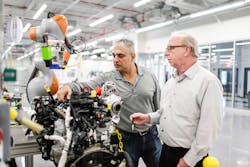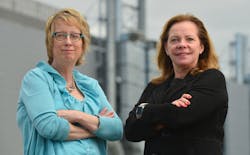Everyone's heard the trope of the manufacturing worker who resists change and—sometimes with good reason—sees technology as a threat. But Dale Mark has a different story to tell about workers and technology from the front lines of a plant floor in Marengo, Illinois. Mark is vice president of operations for UniCarriers, a forklift manufacturer that has been incrementally introducing automation and digital technology into its operations over the past 15 years.
"When we were first installing robots or building automation, there were some people that really embraced it," Mark says. "Other people were skeptical. And today I think there's more of a sense that people crave the technology."
He mentions one of many tiny affirmations: Plant leadership recently introduced a pilot project to manage employees' continuous improvement suggestions on an app. There was no hand-wringing, no harping that the old way was better. Instead, he says, "the response was almost like, 'What have you been waiting for!?'" Marks says it makes sense, as smartphones have become increasingly a part of people's daily lives.
Likewise, when Irene Petrick and Faith McCreary, a pair of Intel researchers, embarked on a study of manufacturers' challenges around digital transformation, to their surprise they heard little about technological hurdles. Instead, organizational problems prevailed.
Through a multimedia diary app where they could share stories of their work and the technologies they encountered, the overwhelmingly under-age-40 batch of respondents told of IT and OT clashes, departments like purchasing and operations running in their own lanes rather than collaborating, and a hesitancy from leaders to share data that could help workers do their jobs better.
"Workers want to be involved early, they think they should be involved early, and believe they have a lot to contribute from a knowledge perspective about the processes," says Petrick.
It's the leaders who are more hesitant around technology, Petrick says, as digital transformation has evolved into something much bigger than investing in a piece of automation equipment to rachet up a particularly plodding task. Work is changing, artificial intelligence is opening up possibilities and hierarchies are flattening as information-sharing across roles becomes the difference between understanding your customer or process and being snuffed out by a competitor.
"Workers interacting with the manufacturing processes themselves are hungry for change and know they have to do things differently in the future to remain competitive," Petrick says. "Senior leaders seem to be a little more risk-averse, and middle managers are all over the board."
That apprehension stems not from the technology itself, but from the broad cultural and organizational changes it brings.
Digital-savvy manufacturers and people who study them say that involving your people early in digital strategy, investing in training, rethinking and reassigning jobs as tasks, finding your technology champions, and looking for new opportunities are important parts of the equation.
Above, additive manufacturing technician Leron Jones works at one of 23 3D printers at Ford's Advanced Manufacturing Center.
Involve Your People Early
People must be integral to a digital strategy from the beginning, big or small, say Ravin Jesuthasan and John W. Boudreau, authors of Reinventing Jobs: A 4-Step Approach for Applying Automation to Work. And the authors don't mean people in the sense of "How many people can we substitute robots for?"
"It's very easy to get locked into saying, 'Give me back 20% of the labor cost because the robots are doing 20% of the work," says Boudreau. "It doesn't work that way."
Petrick advocates involving engineers, supervisors, tradespeople and line workers with expertise in their areas in "meaningful engagement forums" in the early stages of digital strategizing. Not an annual townhall meeting, but open dialogues "where people come prepared to talk about the environment they work in, the machines they work with, the insights they have and how they've worked with those machines for a long time."
Mike Mikula, chief engineer for Ford's Advanced Manufacturing Center, says that when designing applied technology for the factory, his team will bring in both hourly and salaried people "very early in the process" so they can talk about their challenges, share their expertise of the process and contribute ideas for improvement. This not only improves the end result; it empowers team members who will be using the technology, giving them a voice and a stake in its success.
For instance, when Mikula was a Ford area manager, he oversaw the automation of a particularly cumbersome-to-human-operators gear machine at the Van Dyke transmission plant in Sterling Heights, Michigan, that was slowing up the line.
"The cycle time of the line was very short, with people working very diligently at a very high speed," he recalls. "Many people would have a hard time executing the task in the time that was allowed." His engineering team consulted with skilled tradespeople and team leaders on the floor "to ideate around what we could do to help people execute the meshing of the gears in the time we had allotted." Mikula's team took those ideas and worked with different suppliers to come up with solutions, then did a design review with the same hourly workers "to agree on concepts to pursue to production and keep them engaged through the development of the production process. It required a significant amount of creative thinking, and we really did get valued input from everybody."
Rethink Work
Jesuthasan and Boudreau advise that leaders stop using the term jobs and instead break down work into tasks—often, tasks that are unsafe or physically difficult for humans to perform—and then determine which tasks are practical for robots to take over and which ones people can shift to and grow into, developing new proficiencies and ways of looking at the operation that increase productivity and open new opportunities for growth. After that, it's just a matter of looking at which traditional skills translate best into which new roles.
Maybe it's middle managers spending more time on coaching their team and becoming more savvy in interpreting data instead of devoting their days to allocating work and monitoring and tracking people, which automation can take over at the granular level. Maybe it's automating welding processes, then training welders to run a new CNC machining center.
Invest in Training
Fifteen years ago, UniCarriers began adding automation and digital technology to its operations, bringing in CNC machining and robotic welding. That was the beginning of a digital strategy that has brought automation to painting processes, lights-out laser cutting and a new ERP system to connect with data collection.
"We didn't have it all figured out," Mark said. It was the company's first step on the road to the "fairly well-defined factory 4.0 roadmap" it has today, "where we're constantly looking at technologies and where we think they apply and where we can implement them in the future."
Retraining workers for data-driven jobs is a big part of that strategy, and Mark says it's a key reason the company's workforce has not contracted with automation—instead, it's actually grown considerably. Training is a combination of in-house (including apprenticeships) through suppliers and a partnership with a local community college.
A retrained welder now rotates between operating robotic welding cells and the CNC machining center. What the new job lacks in hands-on work, it makes up for in higher thinking and less wear and tear and repetition, Mark believes.
The former welder "is more well-versed and can have more flexibility, which I think you know many individuals like," says Mark. "Also, doing manual welding full-time is strenuous work," so the job becomes more ergonomic. "The individuals like that and they recognize that."
UniCarriers' digital strategy also had provisions for retraining for "a new level of support that was more technically skilled maybe than the typical operator, but didn't require a degreed engineer"—a maintenance technician who could program robots and laser cutting machines. "That was an area that we really had to develop internally," says Mark.
Ford technical specialists Harry Kekedjian and Frank Maslar analyze a cobot.
Think Big
The redeployment of its talent has opened up opportunity for UniCarriers to bring more manufacturing in-house. When the company started its automation journey, it was building forklift frames but outsourced the components for the masts—the vertical lifting mechanism on the front of the forklift.
"There were very large pieces of rail that have to be processed prior to welding, and we had previously had that work done on the outside by a supplier," says Mark.
The engineering team studied that process, and determined the company could cut costs and reduce inventory by doing the work in-house. They were right, and the company soon began looking for other ways to insource. The Marengo plant now assembles its internal-combustion forklift engines and transmissions in-house as well. (UniCarriers already owned the engine technology and purchased the transmission supplier a few years ago.)
Intel's Faith McCreary, left, and Irene Petrick.
"We made that investment and then we trained our employees to run those machines, and now we're making tight tolerance machine castings that go into transmissions for forklifts day in and day out," Mark says. The forklift business is very competitive, he adds.
Becoming more vertically integrated allows UniCarriers to control the cost, quality and delivery, and gain an edge on the competition.
The workforce is organically a part of that strategy and change, says Mark. "When we're looking to develop a new application or a new process, we always involve the shop-floor employees and supervisors early on because they're the experts," he says. "And we draw from their knowledge to understand how we can make the process better and learn where we might have problems today and how we can eliminate those troubles in the future."








